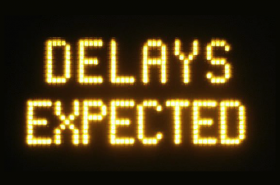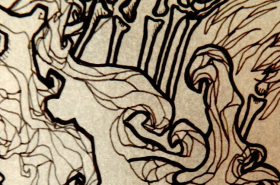Revision. For many writers, I may as well have said Root Canal. They dread it like they do a jury duty summons. They know it’s necessary but hate every second of it.
I’m not one of those writers. Revision is actually my favorite part. There’s something so satisfying in tearing apart a story to reassemble it in a better version, polishing and cutting and rearranging it like pieces in a puzzle until everything finally clicks. I don’t fear the delete button, I wield it proudly. That 6 page scene I slaved over for three weeks still isn’t working? Buh-bye! Two-thirds of my story is riddled with plot-holes, superficial characters and overall stinkage? Adiós! The word count is too high for the magazine I want to submit to? No problem, let me grab my scalpel.
How am I able to freely chop my manuscripts into little mutilated bits? I don’t marry my words. Maybe that’s a perk of writing like a film director. I don’t see words on a page, I see the scenes themselves. The words are just a way for me to communicate those scenes to my audience. They’re my camera. So when what I’m trying to convey gets lost in translation, I have no problem chucking them and trying again.
I know, I’m extreme. Cutting an entire section is most writer’s worst nightmare. But sometimes, that’s exactly what needs to happen in order to save your story. Sometimes, you have to strip it down to it’s bare bones before you can build it back up. Sometimes, you have to hit delete.
Similar to “kill your darlings,” which tells us our favorite phrases are also the cancer of our manuscript and should be instantly removed, you have to divorce your words before you can successfully revise. Easier said than done, right? I know how hard it is for some of you to disconnect from those precious patterns of words and beautiful phrases, to see past the letters to the plot itself. Which is why I decided to write this post. I’m going to teach you my method of revision in the hopes that it helps some of you become less afraid of the process. ![]()
Step 1: Remove the Rose-Colored Glasses of Creation
Let’s face it, when we’re wrapped up in a love affair with our muse, we think everything we write is brilliant. There are days when we know it isn’t, because we’re having a lover’s spat with the fickle biatch, but deep down, we still think our manuscript can do no wrong. Everything is tinged with the rosy glow of creation.
You’ve heard of the runner’s high, yes? The rush of endorphins that provides runners with a euphoric moment in paradise? Well, I believe creative people feel a similar burst of euphoric pride, a creator’s high if you will, that prevents us from seeing our work the way the rest of the world will. So the first step in my revision process is to disconnect from the piece. Set whatever you’re working on aside and wait for the creator’s high to wear off. This can take anywhere from a day, to a couple weeks. But once you’re no longer creatively invested in the piece, you’ll be able to see it through the harsh lens of reality and objectively assess it.
Step 2: Strip to the Bare-Bones
Once our judgement is no longer clouded, we can easily spot flaws, the scenes that just aren’t quite right, the wonky phrasing, the plot holes. Don’t get discouraged though, that’s exactly what we want. Because now you’re in editing mode. One of an editor’s jobs is to see past the words to the skeleton beneath. So that’s exactly what step 2 is about.
Read your manuscript again, ignoring the small things, the weird word choices, the rocky sentences, the missing punctuation, and focus on the scenes themselves, the flow of the story. (Click here if you need an explanation on what I consider “flow.”) Channel your inner film director and watch your story unfold in your mind. Kind of like one of those computer generated posters that contained a 3-D image if you crossed your eyes and stared long enough, (Yep, fads from the ’90′s for the win!), the words should fall away and you should be left with just the visuals they contained.
Those visuals are what I consider the skeleton of a piece, the bare bones. Once you have stripped away all the clothing, fat and useless fluff that masks the underlying architecture, you can analyze that skeleton, looking for cracks and weaknesses and in some extreme places, breaks. Much like a doctor examines x-rays, devising a strategy to repair the damage, an editor uses the bare bones of a story to identify and repair problems with the overall flow and structure. Which brings us to step 3.
Step 3: Divorce Your Words
This is where a lot of you are likely to rebel, because it’s where you’ll move from simply identifying the issues to becoming the surgeon that fixes them. And that’s a transition a lot of you might not like. (Warning, it involves heavy use of the delete button.)
Keeping the visuals from step 2 in mind, read your manuscript again. This time, compare what you’re reading to what’s in your head. Do they match? Do the words accurately convey the emotional content, the action, the details of the scene? If not, can it be fixed with a few minor tweaks or smoothing? (Not all editing has to be dramatic, after all.) Sometimes it just takes a minute shift of a single word or phrase to make everything perfect. But if the gap between the scene as you imagine it and what’s on the page is as large as the grand canyon, then you’ll have to do something more drastic– rewrite.
This is what it means to divorce your words. Highlight the trouble passage and say, “sayonara!” No alimony, no visitation, just rip it off like a band-aid and hit delete. (If that terrifies you, you can cheat slightly and copy/paste the original passage into a different file. That way you still have it if you don’t like the new version. But trust me, you’ll never need that safety net.)
Now that you have a blank slate, picture the scene as clearly as you can and try to recapture it. You’ll be surprised how often the second, (or third, or fourty-fifth), attempt is dramatically improved over the original. My theory is that the original acts as a dry-run. In film, they’d call it blocking in the scene. It’s essentially a rough draft placeholder meant to provide guidance for the real thing in terms of lighting, mood, choreography, etc. It helps the director organize their thoughts so that when the time comes to film it for real, it’s smooth sailing. Plus it’s cheaper to work out the kinks without the actual actors.
A similar thing happens when you rewrite. Rather than try and force the original to behave, you are free to start over. But because you’ve already practiced, it’s easier to write this time, and the result is a closer translation of the scene in your head.
That’s really all there is to it. Three simple steps that can take you from laboriously beating a broken carcass of letters into a semblance of what you hoped for to a liberating experience that gets you closer to your original goal. This method might not be for everyone, and that’s quite OK. But if you find yourself dreading the revision process like you would going to the dentist for that root canal, give it a try. Kick your words to the curb and you might just save your sanity as well as your story.
**Originally posted on Nightwolf’s Corner, Feb 1st, 2013.**




Ashley
A REUT canal, if you will? 😉